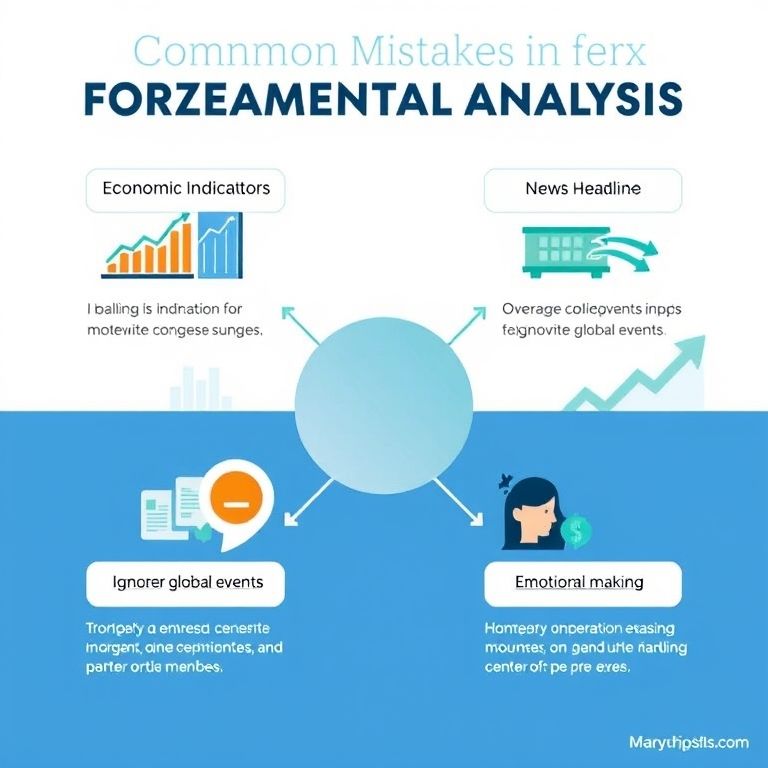Common mistakes in forex fundamental analysis
Common mistakes in forex fundamental analysis
Intro: In fast-moving markets, fundamental analysis can be a compass, not a crystal ball. Yet traders—especially in prop shops where every basis point matters—slip into predictable traps: chasing headlines, treating revisions as certainties, or ignoring how cross-asset dynamics reshape a currency pair. This piece lays out the typical missteps, practical fixes, and why a cross-asset view matters as you scale from forex into stocks, crypto, indices, options, and commodities. We’ll also peek at DeFi, AI-driven trading, and the future of prop trading so you can spot the trends without getting burned by hype.

Common mistakes to avoid
- Relying on a single data point. A strong payroll print or a hot CPI reading can tilt the tape, but one release rarely tells the full macro story. The right approach weighs several indicators, scenarios, and the odds of revisions.
- Ignoring revisions and expectations. Markets price in consensus forecasts. When a release surprises, the reaction is about the gap between actual and expected, not the direction alone.
- Reading narratives instead of probabilities. Headlines matter, but the real edge comes from framing data as scenarios with likelihoods, not as certainties you must defend.
- Overfitting to backtests. A model that screamed buy on past inflation prints may crumble in a new regime. Real-world robustness means stress-testing across regimes, not chasing a nice fit.
- Skipping cross-currency and rate-path thinking. A strong domestic print can be offset by a hawkish central bank surprise or by global funding conditions. Context matters.
- Neglecting risk controls. Position sizing, stop logic, and risk budgeting are as important as the view itself. A great thesis dies quickly without disciplined execution.
- Chasing “hot” signals in isolation. In markets, correlation is noise until a regime shift locks them in. Don’t anchor to one market’s move without checking the rest of the map.
- Subpar data hygiene. Using noisy sources, old calendars, or biased summaries leads to biased conclusions. Clean, timely data drives better decisions.
What to do instead
- Build a macro framework. Map growth, inflation, policy paths, and capital flows. Assign probabilities to plausible scenarios and update them as data lands.
- Think in probabilities, not absolutes. Create mini-scenarios for different rate paths, geopolitical outcomes, and global growth trajectories. Treat trades as bets on those scenarios with defined risk.
- Look across horizons. Short-term moves can be noise; longer horizons reveal regime shifts. Combine data from daily releases with quarterly trends and longer-cycle indicators.
- Use cross-asset cues. Equities, bonds, commodities, and crypto can reveal risk appetite and liquidity conditions that feed currencies. A broad view helps you separate noise from signal.
- Ground conclusions in reliability. Favor robust data sources, confirm with revisions, and avoid overreacting to a single surprise.
- Pair fundamentals with digestion skills. Simple budgeting, like a watchlist with triggers, plus light quantitative filters, keeps you in the game without overcomplication.
- Maintain a journal and test ideas. Record your thesis, data you used, outcomes, and what you learned. Walk-forward testing keeps you honest.
Why this matters beyond forex
- In prop trading, a disciplined cross-asset process scales. A viable forex view can hedge or complement positions in stocks, indices, or commodities. Understanding how policy shifts ripple across markets strengthens your edge and protects the downside.
- Across assets, diversification sharpens risk management. If your macro thesis holds across several instruments, you can allocate more confidently and avoid crowding in one crowded trade.
DeFi, AI, and the changing landscape
- DeFi brings open liquidity and 24/7 access, but it also adds oracle risk, fragmented data, and regulatory ambiguity. As you translate macro insight into trades, keep an eye on how smart contracts, liquidity pools, and cross-chain data feeds affect pricing incentives and slippage.
- AI-driven trading is reshaping tempo and scale. Natural language processing of central bank statements, sentiment signals, and macro indicators can speed up hypothesis testing. The caution: avoid data snooping and overfitting; keep human judgment in the loop to interpret context and regime shifts.
Future trends and a few slogans to keep handy
- The smart contract edge: rules-based execution with transparent risk controls can reduce emotional trading and speed up disciplined responses.
- AI plus analyst intuition: machines handle data deluges; humans interpret narrative and policy nuance. The best setups blend both.
- In prop trading, expect pipelines that ingest macro signals, cross-asset checks, and automated risk adjustment. The frontier is not just speed but the quality of interpretation.
Reliability tips and practical strategies
- Start with a hypothesis log. Before you trade, write the thesis, the data, and the counterarguments. Review and adjust.
- Backtest out-of-sample and stress-test. Include regime changes, not just the most recent data window.
- Use simple models as sanity checks. If complexity doesn’t beat a straightforward framework, ease off.
- Set clear risk budgets. Define max drawdown limits, not just profit targets, and scale exposure with confidence in the thesis.
- Cross-check with multiple asset signals. If forex aligns with equities and commodities under the same scenario, your case strengthens; if not, probe further.
Slogan to remember
- Read the macro, not the noise. Trade smarter across assets, not harder in one lane.
Bottom line: Common mistakes in forex fundamental analysis are typically about overconfidence in a single data point, underappreciation of revisions, and a lack of cross-asset perspective. A practical, multi-asset framework—bolstered by clean data, disciplined risk, and a dash of AI-assisted insight—lets you navigate the evolving landscape from forex to DeFi and AI-driven markets with more resilience.

